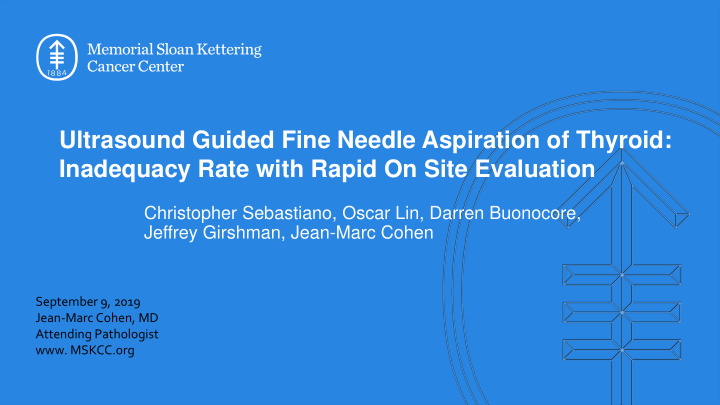



Ultrasound Guided Fine Needle Aspiration of Thyroid: Inadequacy Rate with Rapid On Site Evaluation Christopher Sebastiano, Oscar Lin, Darren Buonocore, Jeffrey Girshman, Jean-Marc Cohen September 9, 2019 Jean-Marc Cohen, MD Attending Pathologist www. MSKCC.org
Disclosure of Relevant Financial Relationships ECP requires that all faculty in a position to influence or control the content of CME disclose any relevant financial relationship WITH COMMERCIAL INTERESTS which they or their spouse/partner have, or have had, within the past 12 months, which relates to the content of this educational activity and creates a conflict of interest. Dr. Jean-Marc Cohen declares he has no conflict(s) of interest to disclose.
Meta analysis data in the literature has shown an average inadequacy rate for thyroid ultrasound guided fine needle aspiration (UFNA) of 13%
Acta Cytologica 2012;56:333 – 339
We investigated the inadequacy rate for UFNA recently performed at our institution with rapid on site evaluation (ROSE).
Materials and Methods We searched the electronic medical record for cases of thyroid UFNA performed at our institution over one year. Procedures were performed by radiologists or interventional cytopathologists and all underwent ROSE by a cytotechnologist and cytopathologists using telecytology, or by the cytopathologist performing the procedure.
Materials and Methods In most cases a single pass was obtained. Specimens were considered adequate if at least 6 clusters of 10 follicular cells were present.
Results ❑ 618 Cases identified ❖ 461 Performed by radiologist ❖ 157 Performed by interventional cytopathologist ❑ 607 Adequate both at ROSE and Sign out. ❑ 3 Inadequate at ROSE but adequate at sign out. ❑ 2 Adequate at ROSE but inadequate at sign out. ❑ 6 Inadequate a ROSE and sign out.
Results ❑ Overall inadequacy rate was 8/618 (1.29%) ❑ Inadequacy Rate for cases performed by radiologist: 6/461 (1.30%) ❑ Inadequacy Rate for cases performed by cytopathologists: 2/157 (1.27%)
Conclusion Thyroid UFNA performed with ROSE substantially reduces the inadequacy rate at our institution as compared to the average reported in the literature.
Conclusion Comparable inadequacy rates are found in procedures performed by radiologists and cytopathologists
Conclusion By lowering the inadequacy rate ROSE reduces the need for re-biopsy, cutting costs and avoiding additional patient discomfort and anxiety.
Recommend
More recommend